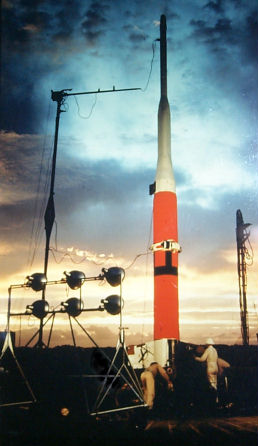POLARIS FTV FACT SHEET
By Cliff Lethbridge

Polaris FTV On Launch Pad, Photo Courtesy U.S. Navy
Classification: Research Rocket
Length: 40 feet, 6 inches
Finspan: 8 feet, 6 inches
Date of First Cape Canaveral Launch: April 13, 1957
Date of Final Cape Canaveral Launch: June 24, 1958
Number of Cape Canaveral Launches: 18
As Lockheed embarked on an innovative effort to develop a brand new, solid-fueled Fleet Ballistic Missile (FBM) for the U.S. Navy, a decision was made to use their existing solid-fueled X-17 research rocket as a test-bed for groundbreaking FBM technology. A series of launches of X-17 rockets would serve to validate some of the innovations planned for incorporation on the new FBM fleet, including guidance mechanisms, nose cone technology and overall flight dynamics. The X-17 launches would prove to save valuable time and money, since any potential technical problems could be ironed out before the actual missile prototypes were manufactured and launched. Once the initial U.S. Navy FBM offering was named Polaris, the X-17 rockets used during flight tests became known as the Polaris Flight Test Vehicle, or Polaris FTV. In all other respects, the Polaris FTV was identical to the X-17.


